by Jena | Jan 13, 2016 | Radiation Therapy |
Dad started his total skin electron beam (TSEB) treatment on Monday. He will complete 8 sessions, once per day, for this second round of TSEB. Dad had his first round of TSEB treatments this past summer. It really did “melt” those tumors away. We are hoping for a similar result this time.
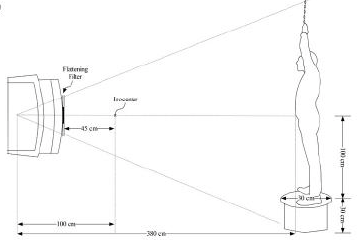
Example of what Dad calls the rotisserie.
When Dad speaks to the doctors and nurses about TSEB, he often talks about being on the “rotisserie.” Everyone gets a good giggle. But, once you learn exactly what is entailed, it sounds more like a medieval torture device. In lieu of a photo taken by Dad of the rotisserie at the Moffitt Cancer Center at International Plaza (MIP), I located a drawing of a similar rotisserie.
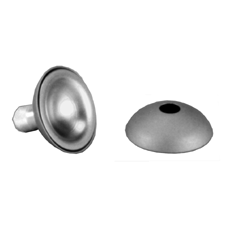
Internal eye shields for protection.
Each day’s session begins with Dad disrobing out of his regular attire and dressing in a flimsy, overly-ventilated gown. Dad is always cold in a shirt and slacks, even in the heat of the Florida summer. He dreads putting on the airy gown. He has asked to wear two gowns. He has asked for the staff to reduce or stop the air conditioning. Nope. Cool and breezy is the way it remains in the treatment room. Once Dad is in the gown, he lies on a table where they stretch his eyelids to insert the internal eye shields, which serve as protection from the radiation. According to Dad, some nurses do a more gentle, less painful insertion while others do not.
After the eye shields are inserted, Dad is unable to see. He is then stood up and walked over to the round platform. Once up on the round platform, additional protections are implemented. First, he is given a pair of heavy lead gloves to cover his hands. He then raises his gloved hands up to the ring above his head. The ring provides Dad stability and also keeps his arms raised to allow for adequate radiation exposure to his sides, chest and back. To protect his feet, they put a slab of “jello” on the top of each foot. Each jello slab is approximately 8″x8″X1″. He then has a cylinder of “jello” wrapped around each heel to protect the back of his foot. During the treatment, Dad spins on the round platform. His top half and bottom half of the body are each treated for 7 minutes for a total of 14 minutes on the rotisserie.
 Dad may blindly spin on the rotisserie for the next 6 days, but he’s not chicken to endure the medieval torture called TSEB.
Dad may blindly spin on the rotisserie for the next 6 days, but he’s not chicken to endure the medieval torture called TSEB.
P.S. Dad had his blood drawn and counts checked on Monday. His hemoglobin level was 8.4. Platelet count was down to 21. White blood cell count was down to 1.86.
by Jena | Jan 8, 2016 | Brentuximab Vedotin, Radiation Therapy, Stem Cell Transplant |
As another step in the pre-transplant testing phase, Dad started his day with 20 vials of blood drawn. The blood will be tested for additional organ functions and past exposure to diseases. Dad’s white blood cell count was lower today at 1.74. His hemoglobin is adequate at 8.5 due to his blood transfusion. The platelets are still low at 22. His platelet count will need to be 50 in order to get his central line catheter placed. Dad may need a platelet transfusion the day before his central line catheter procedure is done.
Next, we met with Denise, the transplant coordinator, and Dr. Ayala, the transplant doctor, for Dad’s re-evaluation visit. This purpose of the visit was to review the vital organ testing results and finalize the plan for transplant. Denise said that Dad was one Dr. Ayala’s three patients being seen this afternoon for the re-evaluation visit. Perhaps the three of them will be “neighbors” in the transplant unit for 20+ days.
Denise shared the news that one of the two matched donors is able to accommodate the new transplant date of February 9th. The donor is a 31 year old, European male. We were delighted to hear that Dad and his donor are a 10/10 match. I confirmed with Denise that the better Dad and donor are matched, the less chance for GvHD for Dad.
Dad’s CT scan showed minor sinusitis, some lymph node involvement and cutaneous lesions. Dad’s bone marrow biopsy resulted in a Sézary count of zero. Excellent! Dr. Ayala said that the chromosome analysis revealed an abnormal chromosome, an extra copy of chromosome 8. People usually only have two copies, one from each parent, of chromosome 8. This extra copy may be an indicator of myelodysplastic syndrome (MDS). Dr. Ayala said that the stem cell transplant should address the MDS. Both, Dad’s EKG and echo, were unremarkable and completely normal. Dr. Ayala was very impressed with Dad’s pulmonary function test. Dad must have some large capacity lungs.
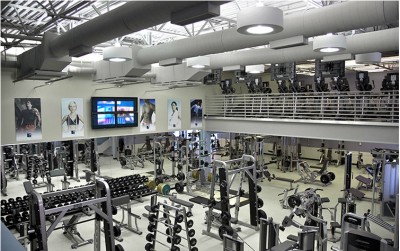
Mom and Dad’s fitness center in their hometown in the Florida panhandle.
Denise remarked that Dad, at 75 years old, is in better shape than 50 year olds that they take to transplant. My parents have been the epitome of healthy. They would “move more, eat less.” Prior to Dad’s cancer, they worked out nearly everyday at their local fitness center. Mom was addicted to Zumba and would get cranky if she missed a class. Mom and Dad took zero prescription medications, which amazed any and all doctors they visited. Even at Moffitt, the doctors refer to Dad as very “healthy.” This seems like an oxymoron.
Dad would not have the opportunity of a stem cell transplant without being very healthy. Dr. Ayala said Dad will be the oldest CTCL stem cell transplant patient Moffitt has had. A key driver of this decision was that Dad is so healthy. Dad set a new goal to go to the gym in their condo once per day. You can imagine with all the treatments, side effects, and tumors that Dad has not been moving and working out as he had before cancer.
Together, Dad and Dr. Ayala signed several consent forms:
- One was consent for the drugs Fludarabine and Melphalan, which are planned for Dad’s conditioning therapy. The purpose of the conditioning therapy is to destroy the cancer cells in Dad’s body. The conditioning therapy starts on the first day Dad is admitted to the hospital, February 4th. In a prior post, I mentioned a Stanford Medicine article that spoke about different conditioning therapies Stanford has been studying for their CTCL stem cell transplant patients. I located a recent presentation of Dr. Youn Kim’s titled “Managing MF and SS with Allogeneic HSCT.” I asked about one conditioning therapy described, in Dr. Kim’s presentation, as a method to reduce GvHD. Dr. Ayala was kind and patient in addressing my inquiry and responding to the printed Stanford presentation slides I put before him on the desk. Dr. Ayala knew of the Stanford research done on that particular conditioning method. It had been published in The New England Journal of Medicine in 2005. He provided his view of the research and shared that Moffitt had a submitted a response to that study. In the end, Dr. Ayala said Dad was getting the best conditioning therapy for his personal situation and that the 2005 Stanford method was not for Dad.
- There were three consents to provide Dad’s data and a blood sample for research purposes within Moffitt and another external organization.
- The last consent was only for patients with European donors. It acknowledges that the European donor may pass Creutzfeldt-Jakob disease, aka Mad Cow disease, onto Dad. At this time there is no test used to identify donors who have Creutzfeldt-Jakob. In recent years, there have been blood and urine tests developed and studied as a reliable screening test. Unfortunately for now, doctors can only confirm the disease with a brain tissue sample. Dr. Ayala reassured Dad by saying that he has never heard of a single transmission of Mad Cow disease in the stem cell transplant community. Dr. Ayala said that it is a “theoretical” risk.
Between now and the admission date of February 4th, Dad continues his radiation therapy with Dr. Montejo. The last radiation treatment is scheduled for January 22nd. Dr. Sokol has squeezed in a second brentuximab vendotin infusion for January 25th.
by Jena | Jan 7, 2016 | Advance Care Planning, Brentuximab Vedotin, Radiation Therapy, Stem Cell Transplant |
Feeling a bit nauseated first thing this morning, Dad started his day at 8:00am at the Moffit Cancer Center’s main campus with a psychological evaluation by Dr. Booth-Jones. Dad claims he “passed.” Dad described several of the activities he had to perform as a part of the evaluation…drawing shapes, selecting alternating colored circles, reading a list of words, repeating sentences read by the psychologist, etc. I actually think Dad found the testing to be interesting and amusing at the same time. I guess we can take heart that Dad is not that loony after all.
All joking aside, I have read that the patient’s mental state before, during and after can impact the outcome of the stem cell transplant. Anxiety and depression have considerable consequences in the months and even years following the transplant. It is best to recognize distress and depression early on through a screening evaluation so that proper psychosocial therapy and pharmacologic medication may be used to help the patient deal with stress before, during and after transplantation. I am appreciative of Dad’s evaluation because Mom and I do not believe Dad would ever admit to being sad or depressed. Dad is constantly trying to remain mentally strong so that Mom won’t worry.
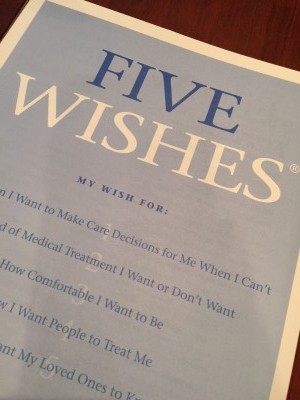
A warm & friendly living will.
At 10:00am, Mom, Dad and I met with Penny, social worker assigned to Dad. We had not met Penny at last week’s meeting with a social worker because Penny was out of the office for the holidays. Penny provided Dad copies of his advance directives (living will and health care surrogate/agent) that he has on file with Moffitt today. I inquired about Five Wishes. I view Five Wishes as a “warm and friendly” living will. Five Wishes also includes the health care agent. Penny said that Dad may use Five Wishes to replace his current one. She also provided another alternative from Project Grace. Penny told us that we could obtain copies of Five Wishes at the Social Worker office rather than order them online from the Five Wishes website. After taking the time to review both, I am recommending that Dad use Five Wishes. I even told Husband that we should update our own advance directives with Five Wishes. I was made aware of Five Wishes through a hospice discussion on the CTCL listserv. (If you haven’t already subscribed to the CTCL listserv and are dealing with CTCL, I highly encourage you to join. It is an online discussion forum with over 1,300 members.)
While riding in the car leaving Moffitt, Dad said we should do some funeral planning. Our family has never been one to avoid or even shy away from end-of-life topics. It probably has a bit to do with personalities. Mom, Dad and I are all type A and appreciate a solid plan…whether is it going on vacation or how one wants to be buried. We LOVE a plan. We keep our conversations about end-of-life light hearted. I got a good giggle when Dad asked me “what do you want at my funeral?” I laughed and reminded him that it is his funeral and that it should be exactly as he wants. Dad then told me that it didn’t matter to him since he “wouldn’t be there” anyway, and it should be what Mom and I want. Classic Dad…ever so selfless.
At 3:30pm, we were at MIP (Moffit Cancer Center at International Plaza). Dad had another dose of radiation to treat the same spots. At 4:30pm, we met with Dr. Montejo, radiation oncology. Dr. Montejo asked how Dad was feeling, and Dad told him about today’s nausea. Dr. Montejo indicated that it could be from the radiation Dad is receiving on his lower spine. That spot is being radiated differently and is “shooting” at Dad from the back and the front. Radiating the lower spine can impact your colon, which may cause nausea. Dr. Montejo had a good look at Dad’s very large tumor on the left/front side of his head..nearly the size of an egg. Dr. Montejo was amazed at how that tumor wasn’t visible when Dad did the radiation simulation two weeks ago. That tumor is open and showing signs of necrosis (visibly black). The good news is that Dr. Montejo indicated that is not infected. Mom was very relieved. Mom takes it personally to be the perfect caregiver by cleaning the open, weeping tumors every evening after Dad showers. She then applies bandages to cover the opens areas. She pads the most sensitive ones hoping the padding will allow Dad to sleep better when he rests his head on his pillow.
Dad doesn’t like to take medication. His whole life, prior to cancer, he would tough it out. He must have thought medication is for wimps. I find I have to tell his doctors that he needs to be encouraged to take pain medication when in pain. Why suffer so much? I had that conversation today with Dr. Montejo. The egg sized tumor is painful. Dr. Montejo convinced Dad to keep a small bottle of OxyContin in his “back pocket” and to take it, if needed. Dr. Montejo feared that Dad might find himself without the ability to get prescription pain medication over the weekend.
Tomorrow is Dad’s last day to do the spot radiation. On Monday, Dad starts eight days of total skin electron therapy (TSET). Dad is not showing any signs of disease on his hands nor feet. This is exciting in that Dad will get to have his hands and feet shielded during the TSET. When Dad did TSET this past summer, I recall Dad having the largest blisters I had ever seen on the tops of his feet. Dad does have a few spots close to his eyes and will have to wear internal eye shields to protect his eyes while radiating around his eyes. If the “egg” and other numerous tumors on his head have not been reduced after those 8 treatments, Dad may receive scalp radiation afterwards.
Tomorrow, Dad will be seen by Dr. Ayala, transplant. Dr. Montejo warned Dad that Dr. Ayala would not like the egg-sized tumor. Dr. Ayala wants Dad to be practically tumor free with no Sézary in his blood before he receives the transplant. I joked with Dad and said that Mom and I could try to cover up the egg with a little concealer makeup…perhaps Dr. Ayala won’t notice.
by Jena | Jan 6, 2016 | Brentuximab Vedotin, Radiation Therapy |
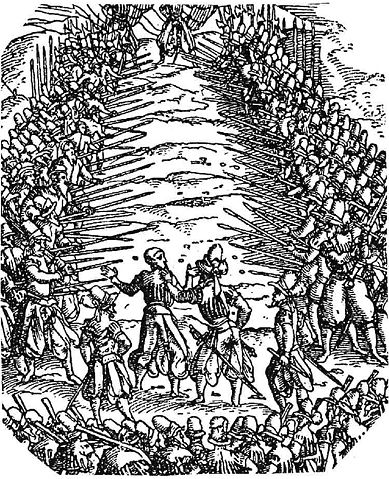
Spiessgasse (Pike-alley), from the Frundsberger War Book of Jost Amman, 1525. Public Domain.
Dad ran the gauntlet today. Upon arrival at the Moffitt Cancer Center at International Plaza (MIP) this morning, the pharmacist informed Dad that she had spoken to Dr. Sokol, malignant hematology, about Dad’s current blood counts. Dr. Sokol felt that they were good enough to start early with the brentuximab vedotin today rather than wait two days until Friday as they originally had planned. Thus, Dad started his day with the unplanned infusion of brentuximab. Next, he received a blood transfusion of two liters (2 bags), which takes several hours. Late this afternoon, Dad spent an hour receiving his radiation therapy. It started with the same locations (head and spine) as Monday and Tuesday’s treatments. The therapy then included new additional sites to treat. Mom actually started to worry since it was taking so long do the radiation. Dad was the last to leave (MIP) at 6:30pm this evening. Dad’s body is certainly taking the punishment. Hopefully, it is the cancer which feels it the most! Dad is exhausted tonight.
by Jena | Jan 5, 2016 | Brentuximab Vedotin, Radiation Therapy |

www.redbullusa.com
Dad went back to the Moffit Cancer Center at International Plaza (MIP) today. His day started with the traditional blood draw to check his counts. Dad’s hemoglobin is slightly down from yesterday’s 8.4 to 7.7. April, the PA at MIP, has scheduled Dad for another blood transfusion tomorrow to stop the downward trend. Dad’s platelets are down to 28. But, the good news is that the Neupogen seems to have boosted Dad’s white blood cell production in 24 hours. Dad ‘s white blood cell count was 0.49 yesterday and rose to 2.27 today. The normal range is 3.5 – 10.5 billion cells/L. Neupogen seems to have given Dad’s bone marrow wings. (Sort of like Redbull for bone marrow!) Dad received his second shot of Neupogen today. I imagine that April is working to ensure that Dad’s blood is good and ready for the brentuximab vedotin infusion on Friday.
Dad also had his second radiation treatment today, which addressed the same spots as yesterday.
Mom, the uber caregiver, was tuckered out today. She was sound asleep on the sofa by 7pm. Dad commented this evening how Mom is always prepared when going to Moffit. She carries organized files of Dad’s medical papers, lab reports, his prescription list, a detailed journal that captures his condition on a daily basis, bottles of Boost, snacks, etc. Mom may be petite (all of 5’0″ and 100 pounds), but she is MIGHTY. Thank the Lord for all the mighty caregivers shouldering the invisible burden of their loved one’s cancer.
Page 8 of 10« First«...678910»


 Dad may blindly spin on the rotisserie for the next 6 days, but he’s not chicken to endure the medieval torture called TSEB.
Dad may blindly spin on the rotisserie for the next 6 days, but he’s not chicken to endure the medieval torture called TSEB.




Recent Comments